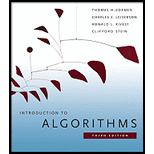
Concept explainers
(a)
To prove that the asymptotic notation
(a)
Explanation of Solution
Given Information:Let
Explanation:
Consider that there exists some constants
The last line ensures the fact that
Therefore,
(b)
To prove that the asymptotic notation
(b)
Explanation of Solution
Explanation:
Consider that there exists some constants
The last line ensures the fact that
Therefore,
(c)
To prove that the asymptotic notation
(c)
Explanation of Solution
Explanation:
Consider that there exists some constants
It is already proved that for
Therefore,
(d)
To prove that the asymptotic notation
(d)
Explanation of Solution
Explanation:
It can be easily prove by removing the equality from the part (a).
The limit definition of
The limit is equal to 0since
Therefore,
(e)
To prove that the asymptotic notation
(e)
Explanation of Solution
Explanation:
It can be easily prove by removing the equality from the part (b).
The limit definition of
notation is as follows:
The limit is equal to
Therefore,
Want to see more full solutions like this?
Chapter 3 Solutions
Introduction to Algorithms
- How can I perform Laplace Transformation when using integration based on this?arrow_forwardWrite an example of a personal reflection of your course. - What you liked about the course. - What you didn’t like about the course. - Suggestions for improvement. Course: Information and Decision Sciences (IDS) The Reflection Paper should be 1 or 2 pages in length.arrow_forwardHow can I perform Laplace Transformation when using integration ?arrow_forward
- I need help in explaining how I can demonstrate how the Laplace & Inverse transformations behaves in MATLAB transformation (ex: LIke in graph or something else)arrow_forwardYou have made the Web solution with Node.js. please let me know what problems and benefits I would experience while making the Web solution here, as compared to any other Web solution you have developed in the past. what problems and benefits/things to keep in mind as someone just learningarrow_forwardPHP is the server-side scripting language. MySQL is used with PHP to store all the data. EXPLAIN in details how to install and run the PHP/MySQL on your computer. List the issues and challenges I may encounter while making this set-up? why I asked: I currently have issues logging into http://localhost/phpmyadmin/ and I tried using the command prompt in administrator to reset the password but I got the error LOCALHOST PORT not found.arrow_forward
 Operations Research : Applications and AlgorithmsComputer ScienceISBN:9780534380588Author:Wayne L. WinstonPublisher:Brooks Cole
Operations Research : Applications and AlgorithmsComputer ScienceISBN:9780534380588Author:Wayne L. WinstonPublisher:Brooks Cole C++ Programming: From Problem Analysis to Program...Computer ScienceISBN:9781337102087Author:D. S. MalikPublisher:Cengage Learning
C++ Programming: From Problem Analysis to Program...Computer ScienceISBN:9781337102087Author:D. S. MalikPublisher:Cengage Learning C++ for Engineers and ScientistsComputer ScienceISBN:9781133187844Author:Bronson, Gary J.Publisher:Course Technology Ptr
C++ for Engineers and ScientistsComputer ScienceISBN:9781133187844Author:Bronson, Gary J.Publisher:Course Technology Ptr- Programming Logic & Design ComprehensiveComputer ScienceISBN:9781337669405Author:FARRELLPublisher:Cengage



